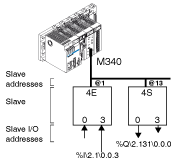|
|
Original instructions
|
|
Family
|
Item
|
Values
|
Indicates
|
|---|---|---|---|
|
Symbol
|
%
|
-
|
-
|
|
Object type
|
I
Q
IW
QW
|
-
|
Digital input channel bit
Digital output channel bit
Analog input channel
Analog output channel
This information is exchanged automatically each cycle of the task to which they are attached.
|
|
Bus and slave number
|
b
|
1 to 999
|
Bus number
|
|
e
|
1 to 31
101 to 131
|
Slave number for bank A
Slave number for bank B (offset of 100 in relation to the slave number of bank A)
|
|
|
Rack number
|
r
|
0
|
Virtual rack number
|
|
Module position
|
m
|
0
|
Virtual module position
|
|
Channel
|
c
|
0 to 3
|
Input or Output channel number
|
